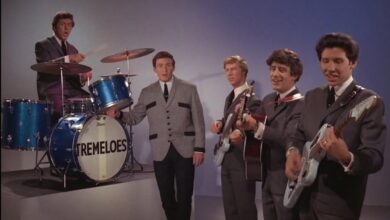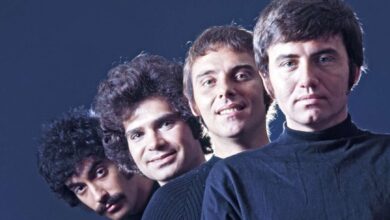Dusty Springfield’s ‘Son of a Preacher Man’ Redefines Soulful Storytelling in 1968
When “Son of a Preacher Man” was released in 1968, few could have predicted the cultural footprint it would leave on the world of soul, pop, and British music. Delivered with Dusty Springfield’s smoky vocals and steeped in Southern gospel grit, the song broke ground by blending British pop with deep American soul, becoming an international hit. It peaked at No. 10 on the UK Singles Chart and No. 10 on the Billboard Hot 100 in the United States, marking a rare feat for a British female artist in the soul genre. But more than just a chart-topper, “Son of a Preacher Man” became a bold emblem of female sensuality, racial crossover, and emotional authenticity during a period of cultural transformation.
Dusty Springfield was already a household name by the time this single was released, known for her powerful voice and platinum-blonde bouffant. Born Mary Isobel Catherine Bernadette O’Brien in West Hampstead, London, she had made waves in the early 1960s with hits like “I Only Want to Be With You” and “You Don’t Have to Say You Love Me.” Yet what set her apart wasn’t just her vocal prowess—it was her deep respect for American soul and R&B, an affection that would lead her to Memphis to record what many consider her magnum opus: the Dusty in Memphis album.
The origins of “Son of a Preacher Man” trace back to the writing duo John Hurley and Ronnie Wilkins. The song was originally pitched to Aretha Franklin, who turned it down at first. Dusty, on the other hand, heard its potential and seized the opportunity. The track tells the tale of a young woman who recalls a passionate teenage flirtation with the son of a preacher. It’s a story both tender and daring for its time, especially with Springfield’s delivery adding layers of nostalgia, longing, and understated sensuality. Her voice walks the fine line between innocence and experience, giving the song a confessional intimacy that resonated widely.
The recording sessions in Memphis brought Dusty out of her comfort zone and into the heart of American soul. Produced by Jerry Wexler of Atlantic Records and backed by the legendary musicians of the American Sound Studio—including the Muscle Shoals Rhythm Section—the track featured a bluesy electric guitar riff, rolling organ fills, and a groove-laden rhythm section. It was a sound unlike anything Springfield had previously recorded, and one that solidified her reputation as more than just a pop singer—she had soul.
Upon its release, the song was met with critical acclaim and commercial success. In the United States, it helped Springfield gain credibility in a market dominated by American acts. It spent weeks on the Billboard charts and introduced Dusty to a new audience that appreciated her depth and authenticity. While the entire Dusty in Memphis album was a critical success, “Son of a Preacher Man” became its standout single, earning her one of her most iconic moments.
Culturally, the song arrived at a time when boundaries were being pushed—in music, in gender roles, and in race relations. A British white woman interpreting Southern Black musical traditions with such conviction was, at the time, revolutionary. Springfield had long been an advocate for racial equality, famously refusing to perform in apartheid South Africa, and her immersion in soul music was both an act of admiration and cultural bridge-building. “Son of a Preacher Man” became a case study in authentic cross-genre fusion, inspiring other British artists to explore American roots music more seriously.
The success of the song opened new doors for Springfield, though ironically, her commercial career soon entered a decline. Nevertheless, her credibility soared, especially among musicians and critics. Artists from Elvis Costello to Chrissie Hynde would later cite Springfield as an influence, pointing to “Son of a Preacher Man” as a masterclass in emotional subtlety and soulful interpretation.
The song’s impact extended far beyond its original release. It was famously revived in 1994 in Quentin Tarantino’s Pulp Fiction, where it soundtracked a flirtatious scene between Uma Thurman and John Travolta. This renewed exposure catapulted the song back into public consciousness and brought Dusty’s name to an entirely new generation. The soundtrack itself went multi-platinum, and Springfield’s song was suddenly back on the airwaves, more than 25 years after its debut.
Over the years, “Son of a Preacher Man” has been covered by dozens of artists, including Aretha Franklin—who had originally passed on it—along with Joan Osborne, Tina Turner, and Nancy Sinatra. Each version brought something new, but none matched the quiet electricity of Dusty’s original. Her interpretation remains definitive, capturing a mood and a moment that transcended time.
Behind the scenes, 1968 had been a turbulent year globally—riots, political assassinations, and generational unrest. For Springfield, who struggled with anxiety, perfectionism, and her concealed sexual orientation, the pressure was immense. But “Son of a Preacher Man” was a moment of clarity and control, where artistry triumphed over chaos. It revealed not only what she could do, but what British pop was capable of achieving when it stopped chasing America and started collaborating with it.
The song’s legacy is cemented in countless “best of” lists, and it’s regularly cited among the greatest recordings of the 1960s. In 2004, Rolling Stone ranked it among the 500 Greatest Songs of All Time. Its blend of pop, gospel, and soul became a blueprint for emotionally rich, genre-defying storytelling in music.
As music evolved in the 1970s and 1980s, the influence of “Son of a Preacher Man” lingered in artists who embraced storytelling, sensuality, and soulfulness in equal measure. From blue-eyed soul singers like Hall & Oates to modern revivalists like Amy Winehouse, the lineage can be traced back to Dusty’s bold reinvention in Memphis.
Dusty Springfield passed away in 1999, just weeks before she was inducted into the Rock and Roll Hall of Fame. But the power of “Son of a Preacher Man” endures—timeless, smoky, and unmistakably hers. It remains not just a highlight of her career, but a landmark moment in the intersection of soul and pop, proving that great music knows no borders.



